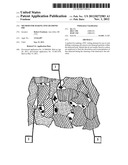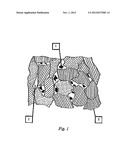Patent application title: METHOD FOR MAKING FINE DIAMOND PDC
Inventors:
Robert Frushour (Ann Arbor, MI, US)
IPC8 Class: AB01J306FI
USPC Class:
51309
Class name: Abrasive tool making process, material, or composition with inorganic material metal or metal oxide
Publication date: 2012-11-01
Patent application number: 20120272583
Abstract:
A method for making a PDC cutting element for use in rock drilling
containing sub-micron size diamond particles within the diamond body.
Metals that do not readily dissolve carbon are employed to limit the
dissolution and re-precipitation of fine diamond during the sintering of
the diamond to the substrate.Claims:
1. A method of making a PDC cutting element comprising the step of:
adding a nonreactive material that exhibits low solubility for carbon to
an unsintered mass of diamond crystals that fills an interconnected pore
network during a high-pressure high-temperature process to equalize the
pressure between the pore network and an external mass.
2. The method of claim 1 wherein the diamond mass is a mixture of various size crystals wherein some of the diamond crystals are smaller than the holes in the interconnected pore network.
3. The method of claim 1 wherein the nonreactive material is copper.
4. The method of claim 1 wherein the nonreactive material is an alloy of copper and a catalyst metal.
5. A method of making a PDC cutting element comprising the steps of: adding a nonreactive material that exhibits low solubility for carbon to an unsintered mass of diamond crystals that fills an interconnected pore network during a high-pressure high-temperature process to equalize the pressure between the pore network and an external mass; and sintering the mixture to bond the mass to a substrate at high pressure and high pressure and high temperature.
6. The method of claim 5 wherein: the diamond mass is a mixture of various size crystals wherein some of the diamond crystals are smaller than the holes in the interconnected pore network.
7. The method of claim 5 wherein the nonreactive material is copper.
8. The method of claim 5 wherein the nonreactive material is an alloy of copper and a catalyst metal.
9. A method of making a PDC cutting element comprise coating diamond crystals that are smaller than pores of an interconnected pore network of a larger diamond mass with a non-reactive material that exhibits low solubility for carbon.
10. The method of claim 9 wherein the diamond mass is a mixture of various size crystals wherein some of the diamond crystals are smaller than the holes in the interconnected pore network.
11. The method of claim 9 wherein the nonreactive material is copper.
12. The method of claim 9 wherein the nonreactive material is an alloy of copper and a catalyst metal.
Description:
CROSS REFERENCE TO CO-PENDING APPLICATION
[0001] This application claims priority benefit of the U.S. Provisional Application Ser. Nos. 61/480,094 filed on Apr. 28, 2011 and 61/487,878 filed on May 19, 2011 in the name of R. Frushour, both of which are incorporated herein in their entirety.
BACKGROUND
[0002] 1. Field of the Invention
[0003] The present invention relates to a sintered polycrystalline diamond composite for use in rock drilling, machining of wear resistant materials, and other operations which require the high abrasion resistance or wear resistance of a diamond surface. Specifically, this invention relates to such bodies that include a polycrystalline diamond layer attached to a cemented carbide substrate via processing at ultrahigh pressures and temperatures.
[0004] 2. Description of the Art
[0005] It is well known in the art to form a polycrystalline diamond cutting element by sintering diamond particles into a compact using a high pressure, high temperature (HPHT) press and a suitable catalyst sintering aid. Apparatus and techniques to accomplish the necessary sintering of the diamond particles are disclosed in U.S. Pat. Nos. 2,941,248 to Hall and 3,141,746 to DeLai.
[0006] U.S. Pat. No. 3,745,623 Wentorf et al. teaches sintering of the diamond mass in conjunction with tungsten carbide to produce a composite compact (PDC) in which the diamond particles are bonded directly to each other and to a cemented carbide substrate.
[0007] It has been proven challenging to produce a PDC with an average grain size of diamond less than about 1 micron. This sub-micron diamond powder is difficult to produce and handle during the processes involved in sintering a uniform diamond body and attaching it to a substrate. Additionally the property of this material to agglomerate and its low packing density produces a diamond compact containing re-precipitated diamond crystals that results in lowering the strength of the overall structure.
[0008] Attempts to overcome the difficulties in sintering sub-micron diamond have been proposed by Hara et al. in U.S. Pat. No. 4,303,442. These solutions, however, do not provide a PDC with enough uniformity in abrasion and impact resistance to be useful in drill bits for deep hole oil and gas drilling.
[0009] It is well known in the art to mix a catalyst with the diamond prior to HPHT sintering in order to provide a uniform mixture of these materials. This is especially helpful when working with very fine grain diamond that is difficult to penetrate with a catalyst when the fine grain diamond is densely compacted. A problem still exists after the catalyst melts since it dissolves the fine diamond grains which re-precipitate as larger diamond crystals in a non-uniform distribution throughout the sintered mass. U.S. Patent Application No. 20090178345 to Russell et al attempts to solve this problem by milling the diamond with a catalyst that itself has a very fine grain size. Unfortunately these finer size catalyst particles combine after melting and create the same problems of dissolving the very fine diamond crystals.
[0010] Thus, there remains a need to effectively control the grain size of very fine diamond used in the formation of polycrystalline diamond cutting tools.
SUMMARY
[0011] A method of making a PDC cutting element wherein a non-reactive material that exhibits low solubility for carbon is added to an unsintered mass of diamond crystals that fills an interconnected pore network during a high pressure, high temperature process to equalize the pressure between the pore network and the external mass of diamond crystals.
[0012] The diamond mass is a mixture of various size crystals in which some of the diamond crystals are smaller in size than the holes in the interconnected pore network.
[0013] The non-reactive material can be copper or an alloy of copper and a catalyst metal.
[0014] In another aspect, a method of making a PCD cutting element wherein a non-reactive material that exhibits low solubility for carbon is added to an unsintered mass of diamond crystal that fills an interconnected pore network during a high pressure, high temperature process to equalize the pressure between the pore network and the external mass of diamond crystals. The mixture is sintered to bond the mass to a substrate at high pressure and high temperature.
[0015] In another aspect, a method of making PCD cutting element includes the step of coating diamond crystals that are smaller in size than the pores of a interconnected pore network of a larger diamond mass with a non-reactive material that exhibit low solubility for carbon.
DETAILED DESCRIPTION OF THE DRAWING
[0016] FIG. 1 is an illustration of a compressed mass of diamond crystals showing the interconnected empty pore network.
DETAILED DESCRIPTION
[0017] The present method incorporates a metal, which is compatible with the catalyst or other sintering aid used to sinter a diamond mass, and does not dissolve carbon. The use of such material retards the dissolution of diamond crystals thereby eliminating recrystallization of very fine diamond into larger crystals that weaken the diamond body or alter its abrasion characteristics.
[0018] When loose diamond abrasive is compacted under high pressure there remains an empty or void pore network throughout the diamond mass. This is a result of the high compressive strength of diamond. Another characteristic of compressed diamond is its ability to form bridges within the compressed mass thereby creating areas of both low and high pressure within the mass.
[0019] FIG. 1 shows a small diamond crystal 1, which is contained in a large hole of a pore network 2, is not under pressure since the larger diamond crystals 3 do all of the work of supporting the structure under pressure. When the molten catalyst sweeps through the pore network it dissolves the small crystal and converts it to graphite. After the molten catalyst fills the pore network, the pressure is equalized so that dissolved carbon from the small crystal, which combines with carbon from other small crystals and from exposed faces of the larger diamond crystals, re-precipitates as a larger diamond crystal. If a metal or other material that doesn't react with diamond fills the empty pores, the pressure on the smaller crystals in the mass will increase to where diamond is the stable phase prior to catalyst sweep through. This retards the dissolution and re-precipitation of the smaller diamond crystals.
[0020] The metal can be added to the un-sintered mass of diamond as a powder by a milling or other procedure or it can be placed between the diamond mass and the substrate. The metal selected should have a melting point sufficiently below that of the catalyst so that it will fully penetrate the mass of diamond crystals prior to the sintering action that is to take place. As an example, copper that does not readily dissolve carbon can be used to infiltrate the diamond mass prior to the sweep through of a catalyst metal, such as cobalt, that has a higher melting point.
[0021] In an alternate method, the metal used to retard diamond dissolution is alloyed with a catalyst. For example, copper that does not readily dissolve carbon can be easily alloyed with catalytic metal, such as cobalt. Copper can be alloyed with many of the known catalyst metals and the percentage of each metal can be adjusted to control the reactivity with carbon in the diamond.
[0022] In another exemplary method, the fine diamond crystals may be coated with a non-reactive material that doesn't readily dissolve carbon. The coating may be thin enough so that it does not entirely fill the holes in the pore network of the larger mass. In this example, the coating serves to retard the dissolution of the fine diamond crystals into the catalyst used to sinter the diamond mass.
User Contributions:
Comment about this patent or add new information about this topic:


